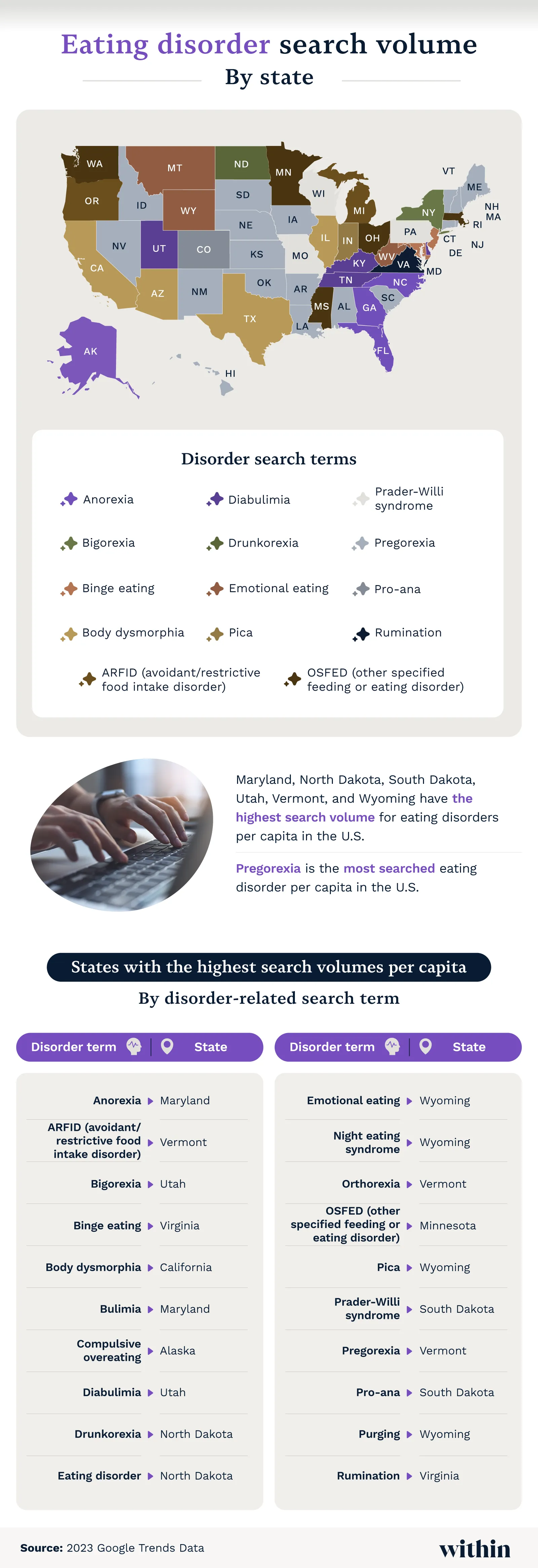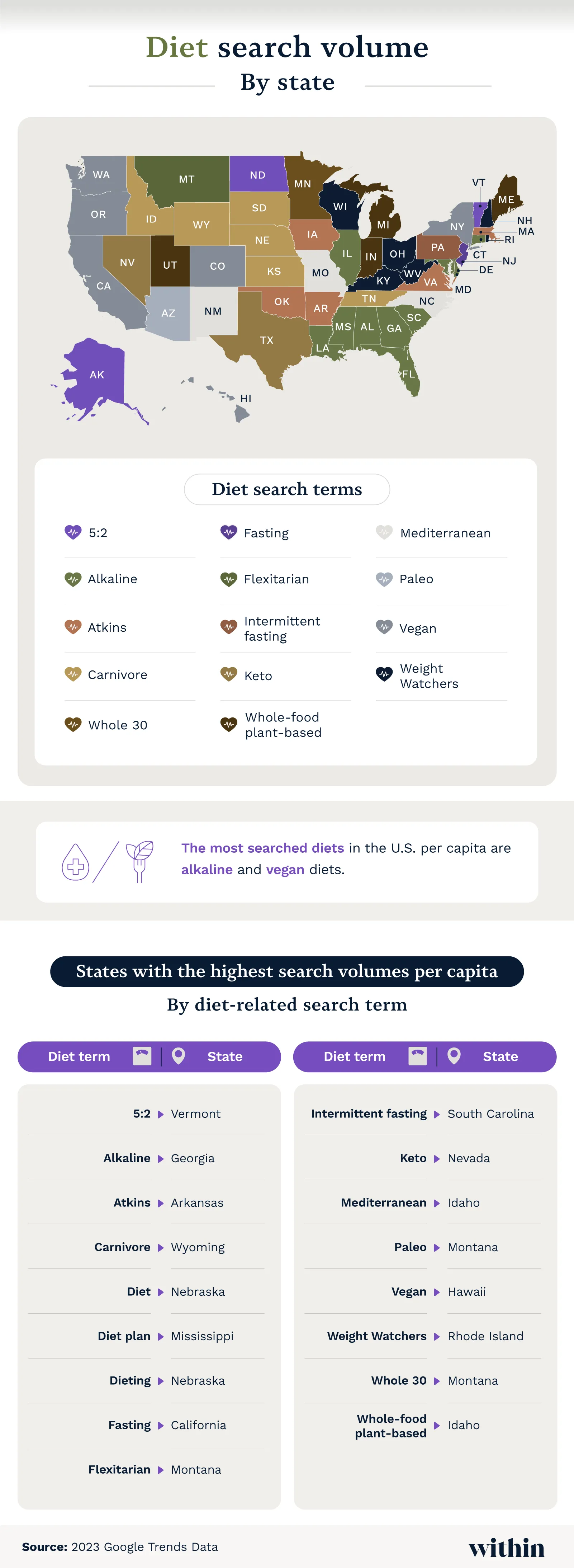
When a person is suffering from an eating disorder, it can be difficult to know what to do. These days, many people’s first instinct is to do a quick Google search to help them figure out where to start. What might these searches tell us about what people across the U.S. are struggling with or need more information about?
Since eating disorders have risen due to the COVID-19 pandemic, we looked into this by studying Google search trends from the past year.1 Read on to find out what terms Americans have been searching for to learn more about common eating disorders and popular diets. We’ll also touch on the fine line between the two.
First, we analyzed each state’s search queries to see which eating disorders residents looked into most.

Overall, the states with the highest search volume for eating disorders per capita in the U.S. were: Maryland, North Dakota, South Dakota, Utah, Vermont, and Wyoming. We also found that these were the top-searched eating disorder terms within each of these states:
Maryland’s top search, binge eating disorder, is typically characterized by episodes of eating a lot of food in a short time period, often in a way that feels uncontrollable and results in distress.2 The International Journal of Eating Disorders found that binge eating increased during the pandemic, causing the disorder to worsen for many people during that time.1
Drunkorexia, which had the most searches in North Dakota, can be recognized by limiting calorie intake in relation to drinking alcohol.3 For example, someone with drunkorexia might skip daytime meals if they plan to drink in the evening, either to get drunk faster or to avoid consuming “too many calories” that day.
South Dakota and Vermont both shared the top search: pregorexia. This condition was also the most searched eating disorder per capita in the entire U.S. Pregorexia refers to any eating disorder someone experiences during pregnancy. As such, a wide variety of signs may indicate it, like food restriction, intentional purging, and not gaining enough weight while pregnant.4
Utah’s most common eating disorder search term was diabulimia. The primary danger of this condition is that it’s specific to people with Type 1 diabetes. People with diabulimia limit the amount of insulin medication they take in an attempt to control their weight.5
Emotional eating disorder, the top search in Wyoming, is when a person’s emotions trigger abnormal eating patterns. While eating can be a normal response to emotions like stress, it can become a disorder when people use it as a coping mechanism. Emotional eating can also lead to a more severe binging disorder.6
Next, we dove deeper into the data to see which eating disorders residents of major cities had the most questions about.

The Diagnostic and Statistical Manual of Mental Disorders, 5th Edition (DSM-5) doesn’t include diabulimia, which could explain why it was the most searched eating disorder per capita across all major U.S. cities in the past year.7 But overall, eating disorder searches were highest in these cities (listed here with each one’s top search):
Pro-ana is a movement that promotes anorexia.8 Since anorexia worsened for many people during the pandemic, it might be a good thing that people in some areas of the U.S. have been looking to learn more about it lately.1
Pica (pronounced “PIKE-uh”) is a condition that involves compulsively eating things that aren’t food. Pica often occurs during pregnancy, among children under age six, and in people with autism spectrum disorder (ASD), intellectual disabilities, and severe mental illness.9
Is it an eating disorder or just a diet? Dieting can lead to an eating disorder if the dieter internalizes the wrong messages.10 With this in mind, we wanted to look at some of the most common diet-related searches by state.

Some search terms were more problematic than others. The most searched diet terms across the U.S. in the last year were:
Most diet searches came from Montana and Nebraska. In Montana, diet searchers were most interested in the flexitarian diet.13 Rather than eliminating all meat like a vegetarian, it allows for the occasional indulgence while still being primarily plant-based the rest of the time. Meanwhile, Nebraska topped the list simply for its many searches for the term “dieting.”
It may be wise to replace certain foods with more nutritious options, but any overly restrictive diet can cause problems. Not only can their limits be hard to maintain, but they can lead to nutritional deficiencies and eating disorders. Failure to follow a restrictive diet can also cause negative feelings and damage a person’s self-esteem.
Next, we applied the same state-by-state analysis to a number of major U.S. cities to see how they differed from the states they’re in.

The most searched diet trend across all major U.S. states per capita was “fasting.” Traditionally a spiritual practice, fasting is a broadly-defined exercise that shows some evidence of having health benefits.14 But the cities searching the most for diet information were the following (alongside their top searches):
It may seem like keto is the new Atkins since both rely on restricting carbohydrates. But there are a few differences between the keto and Atkins diets: Atkins is less restrictive, allowing you to increase your carb intake gradually—keto does not. And Atkins involves slightly more protein than keto, which includes more fat.15
The Whole 30 diet is a trademarked 30-day program that eliminates certain foods like refined sugar, food additives, and alcohol, but also dairy, grains, and legumes. Some of these changes are considered nutritious, but the goal is often to identify food intolerances by eliminating common irritants and then adding them back in one at a time.16
Still, you’re better off working with a doctor to identify issues like those. This is equally true about what to eat as it is for when to eat, which is what the 5:2 diet dictates. Based on intermittent fasting, the dieter barely eats at all two days out of the week.17 This behavior might sound familiar to people who know the early warning signs of anorexia.18
People often search Google for things they want to know more about, like the Marylanders wondering about binge eating disorder symptoms or the Miamians curious about the new term “diabulimia.” But not every answer is from a reputable source, and some online spaces are even dangerous, like those with ideologies that actually promote eating disorders.
And the same goes for dieting deep dives that lead to nutrition misinformation and websites promoting unfounded health claims.19 Talking to a doctor or other licensed specialist (like a nutritionist) may be helpful when wanting to make lifestyle changes. People with eating disorders may also benefit from seeking professional help.20
We used Google Trend search volume data to identify the past year’s online search trends for eating disorders and diets in all 50 states and in the top 50 most populated cities in the U.S.
Recovery is our priority. Within Health offers remote care for a wide array of eating disorders with the support of dieticians, therapists, nurses, and peers.
You’re welcome to share this study for any non-commercial purpose as long as you provide a link to this research as a credit to the original creators.
Eating Disorders Are on the Rise. (2021). The American Society for Nutrition. Accessed March 3, 2023.






Within is committed to providing accurate and up-to-date information on eating disorders and mental health.
Read our editorial policy.